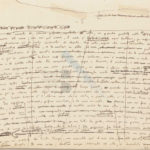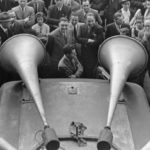La Storia is conceived as a chronicle,similar to Defoe’s masterpiece, A Journal of the Plague Year, and as such encompasses a great many characters. Yet the narration focuses mainly on the lives of four protagonists: Ida (and beyond her, her parents and her ancestors), Nino, Useppe, and Davide Segre, as well as two dogs — Blitz and Bella— two unnamed songbirds, a rabbit that vanishes, and an unnamed cat. All of them die.
And yet the tone of the book is not tragic but rather moves from picaresque to a survival story, with death looming large as an inescapable aspect of life.
Something about Ida is slightly off from the start. Her parents wanted to name her Aida, but an error of the municipal clerk registers her as Ida. We encounter her at 37, a widow: her rather undernourished body, shapeless, the bosom withered, the lower part awkwardly fattened, was covered more or less by an old woman’s brown overcoat, with a worn fur collar and a grayish lining whose tattered edges could be seen hanging from the cuffs of the sleeves.
A dispirited schoolteacher, turned into a life-giver. She is instinctively resourceful: she knows how not to worry about one son and how to protect the other.
For over 700 pages we follow her action and struggles, yet much about her eludes us. We are told of her looks, her actions, her homes; we observe her fears and her courage, and yet we know nothing about her thoughts.
In the classroom where she taught, in the center of the wall, just above her desk, next to the Crucifix, there were enlarged framed photographs of the Founder of the Empire and its King-Emperor. […] However, in Iduzza’s eyes, the images of the two figures (no less, you might say, than the Crucifix, which to her meant only the power of the Church) represented the absolute symbol of authority, that occult and awe-inspiring abstraction which makes laws. In those days, on instructions from higher up, she wrote on the blackboard in large letters, for her third-grade students to copy as a penmanship exercise:
“Copy out three times in your good notebooks the following words of the Duce: Hold high, O Legionaries, your banners, your steel, and your hearts, to hail, after fifteen centuries, the reappearance of the Empire on the fatal hills of Rome! Mussolini“
Ida is frightened by her Jewish origin, which she perceives as dangerous and inscrutably mysterious. Yet she is attracted by the Ghetto, particularly by its women.
Nino is all carefree vitality and unbound enthusiasm, a master at the art of getting by. As a teenager, he is a thug, enthralled by Fascism, and uncaring of his mother’s woes. Soon he grows disillusioned with the dictatorship, picks up arms as a partisan, and fights courageously with the communist-leaning Resistance only to end up disillusioned by all ideologies. He embodies, among much else, the quintessentially Italian trasformismo, the capacity to quickly change political sides.
He has a big heart (we are shown his instinctive love and acceptance for his half-brother and his relationship with his dogs), yet is a womanizer with a predisposition for a free, nomadic and anarchist lifestyle.
Cesare Garboli and other critics have seen him, I believe insightfully, as an Achilles-like figure because of his courage and near-invincibility.
Useppe (Giuseppe), son of a German soldier and a half-Jewish mother —neither circumcised nor baptized— this memorable premature, sickly, innocent, and poetic character, for six years is Ida’s child, companion, and raison d’être. In the midst of wartime fears, poverty, and squalor, Useppe explores his immediate circumstances with the eye of the poet. By observing and naming things and people, he creates a parallel universe which he inhabits.
[…] Any music, to Giuseppe, was a pleasure: even the tormenting notes of the radio in the courtyard, or the clanging of the tram. Any vulgar music, in his little ears, developed in fugues and variations of unknown freshness, precedent to all experience. And even simple isolated sounds (like colors) echoed in him through all their harmonics, as his astute attention perceived even their intimate murmurings…
[…] But even more than by notes, perhaps, Giuseppe was bewitched by words. Obvious words, for him, had a sure value, as if they were one with objects. He had only casually to hear the word dog, to laugh heartily, as if suddenly the familiar and comical presence of Blitz were there, before him, tail wagging. […]
One day, seeing the printed drawing of a ship for the first time in his life, he exclaimed, in a tremble of discovery; “Sip! sip!”[…] Furniture and domestic object became for him, houses, trains. Towels, rags, even clouds were lags (flags). The lights of the stars were grass, and the stars themselves were ants around a crumb (the moon).
Useppe relates with equal raptured intensity to humans and animals. Toward the end of his life, together with his she-dog companion, he discovers a miniature paradise along the Tiber.
Critics, including Amos Oz, see in Useppe a Christ figure; for me, he remains one of Morante’s immortal child-poets, a member of that wondrous elite she describes in The World Saved by Kids: And Other Epics, as the “happy few.”
In 1970, Morante wrote an essay on the Florentine friar/painter Beato Angelico. Graziella Bernabo’ suggests that Angelico is in some sense a poetic model for Useppe. Certainly, Useppe is a precursor of Manuele, the orphaned protagonist of Aracoeli, Morante’s last novel, published in 1982.
Davide Segre, a Jew, is the only northern Italian and the only intellectual in the novel. He presents himself under a variety of disguises: at first as an anarchist named Carlo Vivaldi, later as a Partisan with the battle name Piotr, and finally, at the mercy of his drug addiction, as Morante’s alter ego and a clear-eyed critic of power dynamics, capitalism, and the mechanisms of oppression.
By far, the most tormented character, Davide is in perpetual revolt against his bourgeois origin. In a memorable scene, in a tavern in Testaccio, he lectures the card playing drinkers with drug-induced fever, yet lucid passion, on history, the war, and its millions of dead:
“… all History is a history of fascism, more or less disguised…in the Greece of Pericles … and in the Rome of the Caesars and the Popes … and in the steppes of the huns.. and in the Aztec Empire… and in the American of the pioneers … and in the Italy of the Risorgimento … and in the Russia of the Tsars and the Soviets … always and everywhere ere, sempar e departut, free men and slaves … rich and poor… the buyers and the bought … superiors and inferiors … leaders and herds ..
The system never changes … it was called religion, divine right, glory, honor, spirit, future … all pseudonyms … all masks … But with the industrial age, certain masks won’t hold up … the system bares it’s teeth, and every day on the flesh of the masses it prints its real name and title… and it’s no accident that, in its language, mankind is called MASSES, which means inert matter … And so, here we are… this poor matter, mater, material for work and labor, becomes fodder for extermination and destruction … Extermination camps, this is the system’s real name today! […]
Elsa Morante had a life-long fascination with her dreams. From January to July 1938, she kept a diary, mostly of her dreams and sexual disquietude, which was published posthumously as Diario 1938. There she writes:
It is a strange gift from God to be able to remember, when awake, the different world of dreams.
Interestingly, in La Storia, all four protagonists are frequent dreamers and their dreams/nightmares, reveal much about their inner lives.
It would be hard to describe the many memorable minor characters of the novel without giving away essential parts of the plot, among them, the Mille, Eppemondo, Carulì, Rosa and Celeste, the Marroccos, Mariulina, Ida Di Capua “Ezekiel” the midwife, Giovannino, and Vilma, the mystic Cassandra of the Ghetto.



